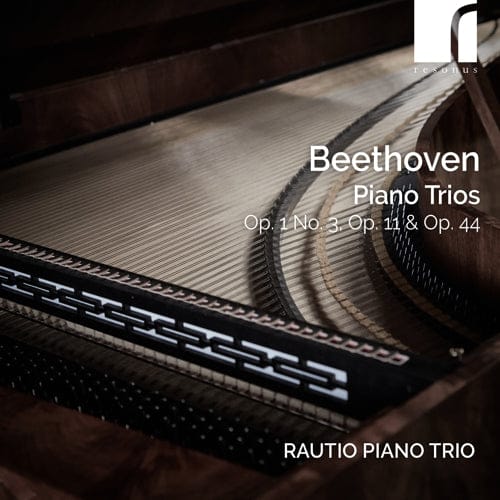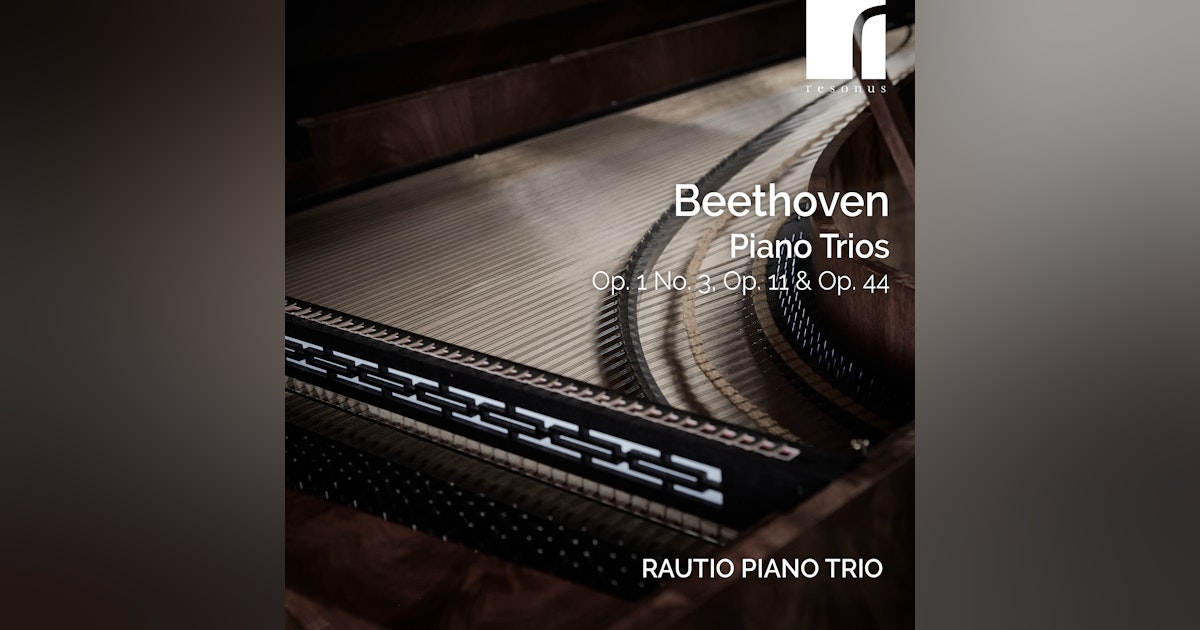The Rautio Trio returns in Beethoven
A truly cherishable disc replete with fresh, youthful, vibrant music-making

We met the Rautio Piano Trio prev9ously with a post entitled What was Beethoven's Op. 1? The answer is three piano trios, and the ensemble played the first two of the on that Resonus Classics disc. Here's the third, coupled with he Trios Opp. 11 & 44.
We also met pianist Jan Rautio in his guise as pianist partner with soprano Nadine Benjamin at the Thaxted Festival this year.
The Rautio Piano Trio records on period instruments he Rautio Piano Trio returns to Resonus with this second volume of Beethoven’s Piano Trios, recorded on period instruments. The album features his Op. 11 trio – ‘Gassenhauer‘ – together with his Piano Trio Op. 1 No. 3, showcasing the young composer’s early mastery of the genre; and his virtuosic Variations for Piano Trio Op. 44. This is the culmination of the Trio’s wider project charting the evolution of the piano trio from its emergence in the mid-eighteenth century, with the music of J.C. Bach, C.P.E. Bach, Mozart and Haydn, through to Beethoven’s complex and mature realisation of the genre.
The insurgents used by the players are a fortepiano by Paul McNulty after Walter & Sons (1805), a violin by Giovanni Battista Rogeri (Brescia, c. 1630), and a cello by Francesco Rogeri
Composed in 1797 the so-called “Gassenhauer” Trio in B flat, Op. 11 can be performed in a vaiety of configurations. The title refers to Vienna's Gasse, or lanes, were popular ones could be heard - in this case on from a popular opera by Joseph Weigl, L'amor marinara - which Beethoven uses in the finale as the basis of a Theme with Nine Variations. But first, a vigorous Allegro con brio, as fest as can be. Both Jane Gordon's violin and Victoria Simonsen's cello sing beautifully, and Radio has wonderful fluency:
This is a massively under-rated Trio- the cello then violin opening of th central Adagio is pure magic, especially hwen played like this - both Simonsn and Gordon's lines ae like purest silk, and in response Ratio finds perfect expressivity (cantabile on the fortepiano is no easy mater, but the lines do indeed sing):
One can hear the popular nature of the tune that launches the finale - and indeed, appreciate its catchiness. And how Beethovenian the launching into counterpoint at a slower tempo while retaining some of the character of the original.
There is a flexibility of instrumentation here. A classic version for clarinet, cello and piano is that of Karl Leister, clarinet, Pierre Fournier, cello, and Wilhelm Kempff, piano on DG (actually the performance I grew up in my teenage years after finding the Kempff Trio box in the bargain bins at a Manchester record shop, Gibb's):
The third of the Op. 1 Trios takes us to Beethoven's favourite key, C-Minor: stormy, serious (think both the “Pathéoque” Piano Sonata and the Fifth Symphony). The first movement plunges us into a darker, more troubled world than Op. 11. his performance of Op. 1/3 by the Rautio Trio perfectly captures the core energy of C-Minor, while allowing for lyricism:
Beethoven provides fine contrast in the slow movement (there are four movements to Op. 1/3, as opposed to three each for Op. 1 Nos. 1 & 2). The Rautio Trio find just the right tempo (t is Andante, not Adagio) fo the piece's freshness to come across as well as its balm. The closing of one variation and the inevitable opening of the next is beautifully done - and Beethoven's use of variation form of course links back to the “Gassenhauer” Trio. Contrasts are beautifully made, and Rautio's upward arpeggios are beautifully light and even:
This Andante cantabile con Variazioni is sublime: if you want to sample this disc, start there. The Menuetto is hardly a dance on would find in a ballroom: it is beshadowed with the minor mode; the use of original instruments gives it an additional underlay of angst (modern instruments can act as an emotional cushion!). The finale is almost fierce - certainly is high-powered, and fas (it is caked “Prestissimo,” after all!). And yet auto's finger wok is exceptional, every note audible:
Finally, the Op. 44 Piano Trio in E flat, a set of “Variations on an Original Theme”. It originates from Beethoven's time in Bonn (around 1792), although it was not published until 1804.
The theme could hardly be simpler: it goes down, it goes up again, occasionally taking a rest. But what a genius like Beethoven can do with such basic material is truly awe-inspiring. This is 13 minutes of jaw-dropping entertainment, and the Rautio Piano Trio capture its quixotic nature to perfection. Trills fizz, motifs are passed from instrument to instrument with aplomb. Superb:
Booklet notes are provided by the pianist of the ensemble, Jan Rautio, while violinist Jane Gordon provides a fascinating essay on performing in historical style. The highest compliment I can pay the recording is that one sadly notices it- everything is in oder, the instruments are well placed in the sound picture, reverb is just right (the venue was Wyasone Concert Hall, Monmouth).
A truly cherishable disc replete with fresh, youthful, vibrant music-making.
The Amazon link is here.


